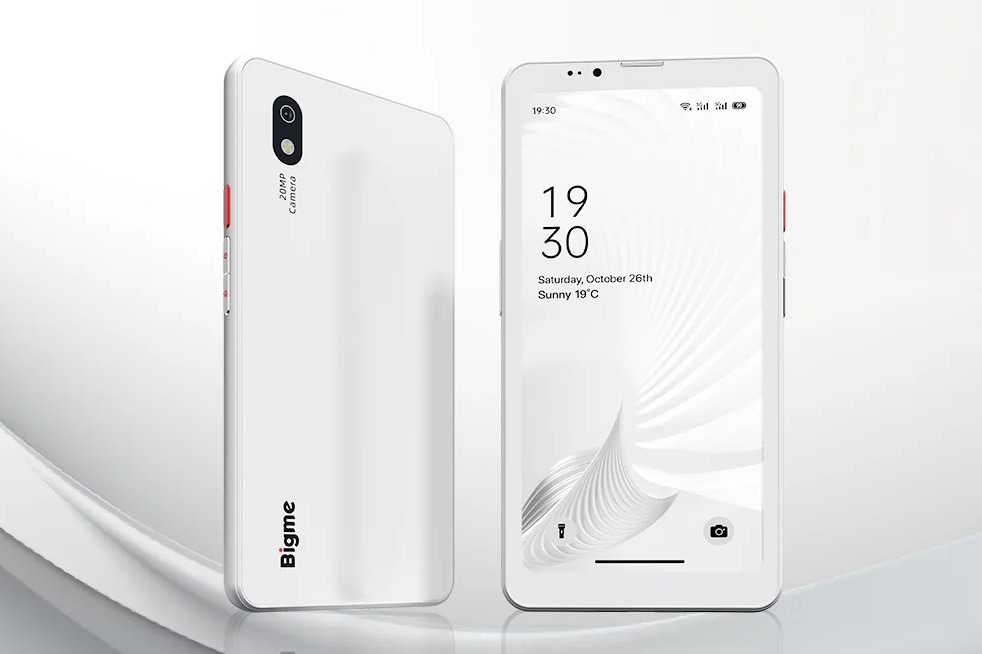
E-Ink Smartphones: The Next Minimalist Trend.
E-Ink smartphones are redefining mobile technology by combining minimalist design, distraction-free interfaces, and ultra-long battery life. With paper-like displays, eye-friendly screens, and energy-efficient operation, they appeal to users seeking focus, simplicity, and sustainability. As digital fatigue rises, these devices offer a calm, intentional alternative to mainstream smartphones, making them the next trend for mindful tech enthusiasts.
✨ Raghav Jain

The Rise of E-Ink Smartphones: A Minimalist Revolution (Approx. 1000 words)
In a world where smartphones grow more advanced and overwhelming with every passing year—brighter OLED displays, faster refresh rates, endless notifications, and power-hungry apps—a counter-movement is quietly emerging. It’s not about more pixels or faster processors; it’s about less. Enter E-Ink smartphones, the devices that embody the philosophy of digital minimalism in a pocket-sized form.
E-Ink (electronic ink) technology, most famously used in Amazon’s Kindle e-readers, is designed to mimic the appearance of ink on paper. Unlike traditional LCD or OLED screens, E-Ink displays reflect ambient light rather than emitting it. This results in a matte, glare-free display that’s easy on the eyes and remarkably power-efficient. The same principles that made e-readers beloved by millions are now being applied to smartphones—and the result is a device that’s both novel and nostalgic.
Understanding the E-Ink Technology
E-Ink screens consist of millions of microcapsules filled with positively charged white particles and negatively charged black particles suspended in fluid. When a current is applied, the particles move to the surface, forming visible text or images. Once displayed, they consume virtually no power to maintain that image—energy is used only to change what’s shown.
This unique property translates into battery lives measured in weeks rather than hours—a stark contrast to modern smartphones that often struggle to last a single day on one charge. While E-Ink screens typically display in grayscale (though color E-Ink displays now exist), they excel in readability, even under direct sunlight.
The Return to Simplicity
The rise of E-Ink smartphones isn’t just about battery life—it’s about reclaiming control over attention. Tech fatigue has become a real modern ailment. Constant pings, alerts, and social feeds fragment our focus and drain our mental bandwidth. E-Ink phones, in contrast, are deliberately simple. They strip away unnecessary apps, limit distractions, and prioritize essential communication—calls, messages, calendars, and notes.
For many, this approach feels refreshing, almost liberating. Instead of being tethered to an addictive glowing screen, users can stay connected without being consumed. E-Ink phones encourage presence, mindfulness, and intention—values that have been increasingly lost in the noise of the digital age.
The Leading Examples
A few pioneering companies are defining the E-Ink smartphone landscape:
- Hisense A Series – The Chinese tech giant Hisense has been at the forefront of E-Ink smartphone innovation. The Hisense A5, A7, and A9 models feature E-Ink displays capable of running Android apps, offering hybrid functionality—a perfect balance between smartphone convenience and e-reader simplicity.
- Light Phone II – Arguably the poster child of digital minimalism, the Light Phone II embraces extreme simplicity. Its E-Ink display supports only essential tools like calls, texts, alarms, and music. No social media. No web browser. The philosophy? “Use your phone less.”
- YotaPhone (Legacy Device) – Before the minimalist trend took hold, the YotaPhone pioneered the concept of a dual-screen smartphone—an LCD display on one side and an E-Ink display on the other. Though the brand faded, its idea planted the seeds for what’s now an entire minimalist tech movement.
Why People Are Switching
The motivations for adopting E-Ink smartphones vary widely, but they all trace back to a growing desire for balance. Some users want to reduce screen time and digital stress. Others want to disconnect without fully unplugging. Environmental enthusiasts appreciate the energy efficiency and longevity of E-Ink devices, while travelers value the battery life and daylight readability.
For writers, readers, and professionals, E-Ink smartphones offer a productivity advantage—less temptation to scroll endlessly and more focus on what matters. Combined with Android’s app flexibility (on certain models), users can install minimal note-taking or reading apps without falling into the trap of digital overload.
Environmental and Health Benefits
E-Ink smartphones consume a fraction of the energy traditional smartphones do, making them a greener alternative. Fewer charging cycles translate into longer-lasting batteries and reduced e-waste. Additionally, the lack of blue light emission makes E-Ink screens gentler on the eyes, reducing eye strain and improving sleep quality for users who check messages before bed.
This aligns with the broader sustainability movement in tech—a push toward devices that last longer, consume less, and encourage healthier habits.
The Future and Challenges of E-Ink Smartphones
While E-Ink smartphones offer impressive advantages, they are not without limitations. Understanding both sides of the equation is essential to appreciating how this minimalist trend may evolve.
Current Drawbacks
- Limited Color and Refresh Rate – E-Ink screens, even the newer color variants, cannot compete with the vibrant colors or smooth animations of OLEDs. Scrolling, gaming, and video playback remain sluggish due to low refresh rates.
- App Compatibility – While Android-based E-Ink phones support apps, many aren’t optimized for grayscale displays, resulting in awkward layouts or visibility issues.
- Higher Cost for Niche Devices – Because E-Ink phones are still a niche market, production costs are relatively high. Users often pay a premium for minimalism.
- Performance Trade-Offs – Many E-Ink phones prioritize efficiency over raw power, meaning they’re not built for heavy multitasking or gaming.
Yet, these challenges may be part of their charm. The limitations themselves enforce the minimalist experience—no streaming marathons, no app-hopping, no distractions. Instead, they serve their intended purpose with elegant restraint.
Emerging Innovations
The technology is evolving rapidly. Color E-Ink displays (like E-Ink Kaleido and Gallery 3) are already improving saturation, making them suitable for magazines, comics, and light app use. Future iterations promise higher refresh rates and better responsiveness, potentially bridging the gap between E-Ink and traditional screens.
Some manufacturers are also exploring hybrid devices—phones that feature both an E-Ink and OLED screen, allowing users to switch modes depending on their needs. In essence, these could offer “focus mode” and “entertainment mode” in a single device.
A Lifestyle Movement, Not Just a Gadget
The success of E-Ink smartphones lies less in their technical prowess and more in their philosophy. They represent a rebellion against the hyperconnectivity of modern life. As people increasingly value mindfulness and intentional living, E-Ink devices are becoming symbols of digital balance.
The Light Phone’s marketing slogan captures this ethos perfectly: “It’s a phone that actually respects you.” That statement resonates deeply with users who feel exploited by attention-economy apps. By choosing E-Ink phones, people aren’t just changing devices—they’re changing their relationship with technology.
Integration with the Modern World
While E-Ink phones are minimalist by design, they are slowly finding ways to integrate smartly with the broader tech ecosystem. For instance:
- Bluetooth and Wi-Fi connectivity allow easy synchronization with smartwatches, earbuds, and laptops.
- Tethering options let users pair an E-Ink phone with a primary smartphone for on-the-go simplicity.
- Eco-conscious brands are exploring modular E-Ink devices—easy to repair, upgrade, or recycle.
As sustainability becomes central to consumer electronics, major manufacturers could soon adopt E-Ink or hybrid displays for secondary screens, notifications, or power-saving modes.
Cultural and Market Impact
E-Ink smartphones are carving out a distinct subculture—tech minimalists, writers, digital nomads, and professionals who crave quiet tech. Online communities have sprung up around “slow technology,” celebrating devices that prioritize calm over chaos.
Although mainstream adoption may take time, trends suggest steady growth. The global push for digital detox and eco-friendly gadgets positions E-Ink smartphones as a compelling alternative for conscious consumers.
The Road Ahead
As technology matures, we may see:
- Dual-mode phones with switchable E-Ink and OLED screens.
- Faster refresh rates enabling smoother scrolling.
- Flexible E-Ink panels for foldable minimalist devices.
- Expanded color ranges for improved usability.
These innovations could make E-Ink smartphones a serious contender in the broader mobile market.
Ultimately, their future depends on whether users—and the industry—embrace the value of digital moderation. The question isn’t whether E-Ink smartphones can do everything modern phones can, but whether we really need them to.
In an era dominated by hyperactive smartphones, overflowing notifications, and screens that demand constant attention, E-Ink smartphones have emerged as a unique and refreshing alternative, offering a minimalist approach that redefines the way we interact with technology, blending efficiency, sustainability, and focus into a device designed for those seeking digital balance and mental clarity. Unlike traditional LCD or OLED displays, E-Ink technology, popularized by devices like Amazon’s Kindle, uses millions of microcapsules containing positively charged white particles and negatively charged black particles suspended in fluid, which rearrange to form images and text on the screen when an electrical charge is applied, and remarkably, once displayed, the image consumes almost no energy, requiring power only to change the display, resulting in battery lives that extend from days to even weeks, a dramatic improvement over conventional smartphones that often need charging daily, and this power efficiency not only appeals to practical users but also to environmentally conscious consumers, as fewer charge cycles reduce energy consumption and e-waste. Beyond energy considerations, E-Ink smartphones embrace digital minimalism, providing an experience free from the distraction-laden environments of typical smartphones; by focusing on core functionalities such as calls, messaging, note-taking, alarms, and reading, these devices reduce cognitive overload and help users regain control over their attention, which is increasingly fragmented by social media, constant updates, and app-driven addiction, making E-Ink phones especially appealing to writers, professionals, and anyone seeking a calmer, more intentional relationship with technology. Leading the market are devices like the Hisense A-series, which run Android apps on E-Ink displays, combining basic smartphone functionality with distraction-free reading, and the Light Phone II, which exemplifies extreme minimalism with support for only essential communication tools and intentional design that promotes digital wellness, while the YotaPhone pioneered dual-screen technology with an LCD on one side and an E-Ink panel on the other, planting seeds for this emerging trend. The rise of these devices also addresses a growing need for eye-friendly technology; traditional smartphones emit blue light, which can disrupt sleep cycles and cause eye strain, whereas E-Ink screens reflect ambient light like paper, dramatically reducing glare and fatigue, particularly under sunlight, and they are more comfortable for prolonged reading, messaging, or note-taking. While E-Ink smartphones offer numerous advantages, they are not without challenges; the grayscale nature of most E-Ink displays (although color E-Ink variants exist) limits vibrancy, and low refresh rates make video playback, fast scrolling, or gaming difficult, while app compatibility can be inconsistent, as many applications are not optimized for monochrome or slower displays, and devices often have modest processing power compared to mainstream smartphones, but these limitations, paradoxically, reinforce the minimalist ethos by curbing excessive digital engagement and promoting focused use. Innovation continues in the field, with color E-Ink screens like Kaleido and Gallery 3 enhancing visual quality, hybrid devices combining E-Ink and OLED displays for dual-mode functionality, and modular designs that support longer device lifespans, repairability, and sustainable consumption, signaling that E-Ink technology is not merely a niche curiosity but a meaningful response to contemporary digital challenges, including tech fatigue, environmental impact, and overconnected lifestyles. The adoption of E-Ink smartphones reflects broader societal trends toward mindfulness, digital detox, and conscious consumption; communities of “slow technology” enthusiasts celebrate devices that prioritize user well-being over engagement metrics, and the emphasis on functionality over entertainment resonates with professionals, students, travelers, and those seeking simplicity in increasingly complex digital ecosystems. Moreover, E-Ink smartphones exemplify the growing intersection between technology and wellness, offering practical tools for productivity while encouraging healthier habits, reducing screen-induced stress, and allowing users to disconnect without fully unplugging from essential communication, making them an ideal companion for people who want both presence and accessibility in their digital lives. As battery life continues to be a major differentiator, these devices highlight the inefficiencies of mainstream smartphones, which drain rapidly despite incremental improvements in battery technology, and demonstrate that innovation can focus not only on raw performance or features but also on user experience, longevity, and sustainability, aligning with the values of the modern, eco-conscious consumer. In essence, E-Ink smartphones represent a thoughtful counterbalance to a hyper-stimulated, attention-driven digital culture, offering a space for calm, deliberate interaction and intentional device use, while gradually expanding their capabilities through color displays, hybrid models, and improved app support, making them a practical choice for those unwilling to sacrifice communication for minimalism. Whether as standalone devices for digital minimalists or secondary tools complementing a primary smartphone, E-Ink phones stand as a testament to the philosophy that sometimes less is more, proving that technology need not always overwhelm but can also liberate, allowing users to reclaim focus, enjoy longer battery life, and adopt a healthier relationship with their devices, ultimately suggesting that the next wave of innovation in mobile technology may not be about faster processors or more features but about designing for clarity, intention, and sustainability in a world saturated with distraction, where devices like the Hisense A-series, Light Phone II, and upcoming hybrid E-Ink phones symbolize a growing movement toward mindful technology, one that balances connectivity with calm, efficiency with simplicity, and modern convenience with timeless usability, signaling a shift in how we define “smart” devices and illustrating that true innovation sometimes lies not in complexity but in elegant restraint and purposeful design, creating smartphones that serve users rather than dominate their attention, while nurturing both mental well-being and environmental consciousness, establishing E-Ink smartphones as not just gadgets, but as instruments of a new digital philosophy that values presence, intention, and sustainability above all else.
In a world dominated by ever-evolving smartphones with bright OLED displays, endless apps, constant notifications, and features designed to capture every ounce of our attention, E-Ink smartphones have emerged as a radical alternative, offering a minimalist approach that prioritizes simplicity, focus, and intentional use, redefining how people interact with technology by embracing the philosophy that less can indeed be more; at the core of these devices lies E-Ink technology, which, unlike conventional LCD or OLED screens, uses microcapsules filled with positively charged white particles and negatively charged black particles suspended in a fluid that rearrange themselves when an electric charge is applied, creating text and images that consume virtually no power to maintain, resulting in battery lives that can stretch from days to weeks, making them ideal for users frustrated with daily charging cycles of traditional smartphones, while simultaneously promoting environmental sustainability by reducing energy consumption and contributing to longer device lifespans, fewer replacements, and decreased electronic waste, all of which align with the growing demand for eco-conscious consumer electronics in a world increasingly aware of climate change and resource conservation; beyond their impressive energy efficiency, E-Ink smartphones appeal to the growing population of digital minimalists who seek to regain control over their attention and mental clarity, as these devices strip away unnecessary distractions, focusing on essential functions such as calling, messaging, note-taking, reading, alarms, and calendar management, which allows users to stay connected without succumbing to the attention-draining trap of social media feeds, push notifications, and addictive apps that fragment focus and increase stress levels, making these phones particularly attractive to writers, professionals, students, and anyone seeking a calmer, more deliberate relationship with technology, while also benefiting travelers, remote workers, and outdoor enthusiasts who value the screen’s glare-free visibility in bright sunlight, which traditional smartphones struggle to provide, alongside their unmatched battery efficiency that makes them reliable for extended trips without access to power; the market for E-Ink smartphones, though still niche, has seen innovation from pioneering brands such as Hisense, whose A-series smartphones integrate Android functionality with E-Ink displays, allowing users to run apps in a more focused and simplified interface, and the Light Phone II, which embodies extreme minimalism by supporting only core communication tools and intentionally limiting functions to encourage users to use their phones less, emphasizing a philosophy of “digital wellness” and intentional device usage, while legacy devices like the YotaPhone, which featured dual screens with LCD and E-Ink, demonstrated the potential for hybrid functionality and inspired the current wave of minimalist smartphones; E-Ink displays, while primarily monochromatic, now include color variants such as Kaleido and Gallery 3, which expand possibilities for reading magazines, comics, and certain app interfaces, though they still lag behind OLED in terms of refresh rates and color vibrancy, which makes video playback, fast scrolling, and gaming less practical, yet this limitation reinforces the minimalist ethos by reducing time spent on non-essential digital activities, redirecting focus toward purposeful interaction and promoting mental well-being; the adoption of E-Ink smartphones also addresses health concerns associated with traditional screens, as they emit no blue light and reduce eye strain, making prolonged reading or device usage more comfortable and improving sleep quality for users who engage with their devices before bed, while their durability and efficiency appeal to environmentally conscious consumers looking for sustainable technology solutions; the trend toward E-Ink smartphones reflects a broader cultural movement embracing digital detox, slow technology, and intentional living, with online communities of minimalists, writers, and professionals sharing tips, experiences, and design improvements, celebrating devices that prioritize user well-being over engagement metrics and attention economy, signaling a paradigm shift in how society defines “smart” devices, not by their feature count or processing power but by their ability to enhance focus, reduce stress, and promote intentional living, and as manufacturers continue to innovate, hybrid devices combining E-Ink and OLED screens, faster refresh rates, improved color rendering, modular repairable designs, and optimized apps promise to expand the functionality of E-Ink smartphones without compromising their core minimalist philosophy; the benefits of these devices extend beyond personal productivity, offering environmental advantages through lower energy consumption, fewer battery replacements, and extended device lifespans, aligning with a growing consumer preference for sustainable, long-lasting electronics, while also supporting users who wish to disconnect from social media, excessive notifications, and constant connectivity without completely unplugging from essential communication, creating a balanced digital ecosystem that allows for meaningful interaction without digital overload; despite their niche status and slower adoption compared to mainstream smartphones, the appeal of E-Ink phones continues to grow as people seek ways to reclaim focus, mental clarity, and a sense of calm in a hyperconnected world, and as technology advances, the integration of color E-Ink, faster refresh rates, and hybrid functionality could make these devices more practical for mainstream users, allowing them to serve both as primary devices for digital minimalists and secondary devices for those seeking a mindful break from the overstimulation of conventional smartphones; ultimately, E-Ink smartphones are not merely gadgets but represent a shift in lifestyle philosophy, demonstrating that technology can be designed to serve humans rather than dominate their attention, offering a pathway toward intentional usage, mental well-being, sustainable consumption, and a calmer digital experience, and as they continue to evolve, they may inspire a new generation of devices that prioritize focus, efficiency, and environmental responsibility, reminding us that in a world obsessed with speed, power, and constant connectivity, true innovation can sometimes be found in restraint, simplicity, and deliberate design, making E-Ink smartphones a compelling example of how minimalism and technology can coexist, offering users the freedom to connect with what truly matters without succumbing to the constant noise of modern digital life.
Conclusion
E-Ink smartphones embody a growing cultural shift toward simplicity, sustainability, and focus. With their paper-like displays, week-long battery lives, and distraction-free designs, they offer a refreshing alternative to overstimulating modern smartphones. While their grayscale screens and slower performance may not appeal to everyone, their minimalist philosophy resonates deeply with those seeking a balanced digital lifestyle.
As innovation advances, E-Ink technology could evolve beyond niche markets to influence mainstream design. Whether as standalone minimalist phones or hybrid companions, they remind us of an essential truth: technology should serve us—not the other way around.
Q&A Section
Q1:- What is an E-Ink smartphone?
Ans:- An E-Ink smartphone uses electronic ink display technology, similar to e-readers, to provide a paper-like screen that consumes very little power and reduces eye strain.
Q2:- Why are E-Ink smartphones gaining popularity?
Ans:- They offer long battery life, minimal distractions, and a more mindful digital experience—appealing to users who want simplicity over endless notifications and screen time.
Q3:- Which are the most popular E-Ink smartphones today?
Ans:- The Hisense A7 and A9, the Light Phone II, and legacy models like the YotaPhone are notable examples leading the E-Ink smartphone market.
Q4:- Can you watch videos or play games on E-Ink phones?
Ans:- Technically yes, but the slow refresh rate makes them unsuitable for videos or fast-moving content; they are designed for text-based tasks like reading, messaging, and calling.
Q5:- Are color E-Ink displays available?
Ans:- Yes, color E-Ink technology (like Kaleido and Gallery 3) exists and is improving, but it’s still less vibrant than traditional LCD or OLED displays.
Similar Articles
Find more relatable content in similar Articles

The Rise of Generative AI in 2..
By 2025, generative AI has tra.. Read More

Edge Computing Explained: Why ..
Edge computing is revolutioniz.. Read More

AI in Education: Personalized ..
Artificial Intelligence is tra.. Read More

E-Ink Smartphones: The Next Mi..
E-Ink smartphones are redefini.. Read More
Explore Other Categories
Explore many different categories of articles ranging from Gadgets to Security
Smart Devices, Gear & Innovations
Discover in-depth reviews, hands-on experiences, and expert insights on the newest gadgets—from smartphones to smartwatches, headphones, wearables, and everything in between. Stay ahead with the latest in tech gear
Apps That Power Your World
Explore essential mobile and desktop applications across all platforms. From productivity boosters to creative tools, we cover updates, recommendations, and how-tos to make your digital life easier and more efficient.
Tomorrow's Technology, Today's Insights
Dive into the world of emerging technologies, AI breakthroughs, space tech, robotics, and innovations shaping the future. Stay informed on what's next in the evolution of science and technology.
Protecting You in a Digital Age
Learn how to secure your data, protect your privacy, and understand the latest in online threats. We break down complex cybersecurity topics into practical advice for everyday users and professionals alike.
© 2025 Copyrights by rTechnology. All Rights Reserved.